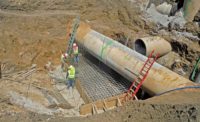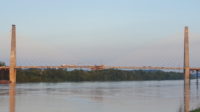ORI Structural Rehabilitation Project
Louisville
BEST PROJECT
Owner: Louisville and Jefferson County Metropolitan Sewer District
Lead Design Firm & Structural/Civil Engineer: Brown and Caldwell
General Contractor: Ulliman Schutte Construction
Sewer Lining Contractor: Boyer Inc.
Tunneling Contractor: Midwest Mole
After a 2018 structural evaluation of a large combined sewer interceptor concluded that sections of the infrastructure under Louisville’s historic Main Street had significant concrete loss, the city brought in Brown and Caldwell and Ulliman Schutte Construction to deliver an emergency solution. Following two months of design and five months of construction, the team repaired approximately 1,400 linear ft of the Ohio River Interceptor while saving the city millions of dollars and minimizing environmental impacts to the Ohio River.
The repair needed to be made quickly because a collapsed sewer on Main Street could cause a sewage overflow of hundreds of millions of gallons to the Ohio River. Related street collapses could result in fatalities, injuries and compromised utilities.
Although the team was not working under a collaborative delivery method, David Hafner, project manager at Brown and Caldwell, says the designer and contractor were brought in at roughly the same time, allowing them to work together toward solutions. “There was tremendous value in having the contractor, the client and the designer all together with the right attitude and working in the right direction to get it done,” he says.
Teamwork was tested early in the project when a partial sewer collapse and related 60-in.-dia conical-shaped void were discovered approximately 80 ft into the ORI.
“When the collapse was found, the contractor was nervous about safely getting workers in there, so they suggested a robust [ring beam] system” Hafner says. “We went back to relook at our design and incorporated the [ring beam] system as the majority of the steel reinforcement needed for the repair.”
The structural design changes accommodated the system to stabilize the tunnel for the first 165 ft. Beyond that distance, the original wall of the ORI was restored by installing new rebar. To repair the void, which was near a section of pavement, crews filled it with grout, plaster and foam slurry.
The team developed “pumparound” routes to minimize risks to constructibility, commuters and downtown businesses. As part of the plan, a 40-million-gallon-per-day pump station was installed with strategically routed piping to limit its visibility and impact on the public.
For rehabilitation of the ORI, crews installed a corrosion-resistant PVC panel liner system and made structural improvements to improve future reliability.
As part of the project scope, the team was able to incorporate three consent decree-required CSO connection upgrades located in the repair area. By completing the CSO upgrades while crews were already working in the area, Brown and Caldwell estimate that the project saved Louisville Metropolitan Sewer District and its ratepayers millions of dollars in future repair costs. The improved CSO connections, with the completion of a nearby waterway protection tunnel, could eliminate an estimated 71 overflow events annually and an estimated 12 million gallons in overflow volume during a typical year.
Despite the early sewer collapse and working during the wettest year on record, the $18-million project was completed within its original schedule and $2 million below its original budget. During 17,000 work hours, the team recorded zero safety incidents.
Back to "35 Best Projects Showcase Midwest Design, Construction Innovation"







Post a comment to this article
Report Abusive Comment